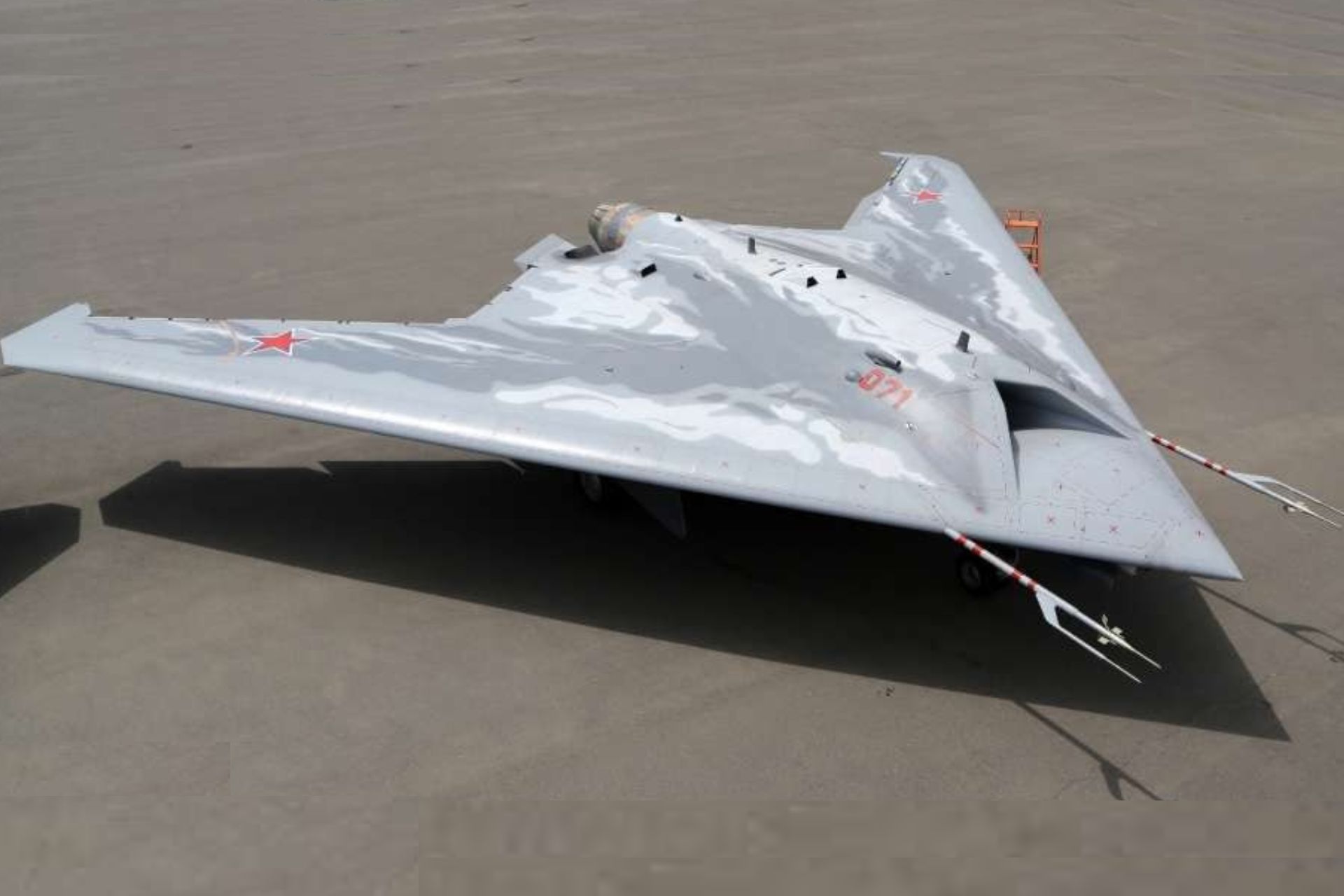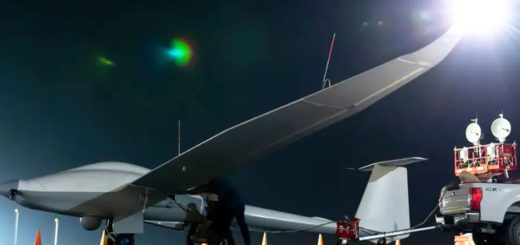Sukhoi S-70: Russia’s 6th Generation Stealth Drone is Here?

{loadposition bannertop}
{loadposition sidebarpub}
Amidst evolving aerial warfare and an increased reliance on drones, Russia has been showcasing the S-70 Okhotnik-B since 2017, with production slated to begin early this year. Developed in collaboration by Sukhoi and the Russian Aircraft Corporation MiG, this stealth unmanned aerial vehicle (UCAV) is regarded as a sixth-generation platform representing a significant leap in unmanned combat capabilities.Follow Army Recognition on Google News at this link
The S-70 is equipped to carry a range of armaments including 250 and 500-caliber bombs, guided and unguided bombs up to 1,000 kg, as well as various air-to-surface and air-to-air missiles (Picture source: Yandex)
The S-70 Okhotnik-B, drawing on design principles from the Mikoyan Skat and integrating technology from the fifth-generation Sukhoi Su-57 fighter jet, was first unveiled in 2017 and has been under development since at least 2011. This heavy combat drone is designed to operate in tandem with the Su-57, enhancing radar and target designation capabilities which allows the use of long-range weapons beyond enemy air defenses.
After a series of ground tests and taxiing trials at the Novosibirsk Aircraft Production Association, the Okhotnik conducted its maiden flight in August 2019. This pivotal event took place at an altitude of 600 meters above the Chkalov State Flight Test Center in Akhtubinsk. Subsequently, in September of the same year, the Russian Ministry of Defense released footage showing the Okhotnik flying alongside a Su-57, indicating its operational synergy with manned aircraft.
The capabilities of the Okhotnik are substantial, equipped to carry a range of armaments including 250 and 500 caliber bombs, guided and unguided bombs up to 1,000 kg, as well as various air-to-surface and air-to-air missiles. Its operational range is enhanced by the AL-31 jet engine, the same used in the Su-27 fighter jet, allowing it to reach speeds exceeding 620 miles per hour and a range of nearly 6,000 km. The drone can autonomously perform complex missions, including takeoff and landing, making it a formidable asset in modern warfare. Its ability to carry various types of munitions, from precision bombs to air-to-air and air-to-surface missiles, enhances its versatility on the battlefield. It also features stealth technologies, including a flat nozzle design that improves its radar invisibility, a critical factor in its effectiveness.
The development of this drone underscores Russia’s strategic pivot in drone warfare, a lesson sharpened by ongoing military engagements in Ukraine. The S-70 is expected to play a critical role in future combat scenarios, leveraging its stealth capabilities, high speed, and significant payload capacity to undertake a variety of mission profiles. Considering the massive use of drones by Ukrainian soldiers and the strategies employed, Russia has accelerated its own UAV programs, including partnering with Iran to produce Shahed drones on its territory.
As global military paradigms shift towards the incorporation of unmanned systems alongside manned aircraft, the S-70 Okhotnik-B represents Russia’s commitment to maintaining a competitive edge in aerospace technology and warfare. Although the full deployment of these drones was planned for this year, the current geopolitical climate and sanctions could influence the pace and scale of their introduction into active service.

{loadposition bannertop}
{loadposition sidebarpub}
Amidst evolving aerial warfare and an increased reliance on drones, Russia has been showcasing the S-70 Okhotnik-B since 2017, with production slated to begin early this year. Developed in collaboration by Sukhoi and the Russian Aircraft Corporation MiG, this stealth unmanned aerial vehicle (UCAV) is regarded as a sixth-generation platform representing a significant leap in unmanned combat capabilities.
Follow Army Recognition on Google News at this link
The S-70 is equipped to carry a range of armaments including 250 and 500-caliber bombs, guided and unguided bombs up to 1,000 kg, as well as various air-to-surface and air-to-air missiles (Picture source: Yandex)
The S-70 Okhotnik-B, drawing on design principles from the Mikoyan Skat and integrating technology from the fifth-generation Sukhoi Su-57 fighter jet, was first unveiled in 2017 and has been under development since at least 2011. This heavy combat drone is designed to operate in tandem with the Su-57, enhancing radar and target designation capabilities which allows the use of long-range weapons beyond enemy air defenses.
After a series of ground tests and taxiing trials at the Novosibirsk Aircraft Production Association, the Okhotnik conducted its maiden flight in August 2019. This pivotal event took place at an altitude of 600 meters above the Chkalov State Flight Test Center in Akhtubinsk. Subsequently, in September of the same year, the Russian Ministry of Defense released footage showing the Okhotnik flying alongside a Su-57, indicating its operational synergy with manned aircraft.
The capabilities of the Okhotnik are substantial, equipped to carry a range of armaments including 250 and 500 caliber bombs, guided and unguided bombs up to 1,000 kg, as well as various air-to-surface and air-to-air missiles. Its operational range is enhanced by the AL-31 jet engine, the same used in the Su-27 fighter jet, allowing it to reach speeds exceeding 620 miles per hour and a range of nearly 6,000 km. The drone can autonomously perform complex missions, including takeoff and landing, making it a formidable asset in modern warfare. Its ability to carry various types of munitions, from precision bombs to air-to-air and air-to-surface missiles, enhances its versatility on the battlefield. It also features stealth technologies, including a flat nozzle design that improves its radar invisibility, a critical factor in its effectiveness.
The development of this drone underscores Russia’s strategic pivot in drone warfare, a lesson sharpened by ongoing military engagements in Ukraine. The S-70 is expected to play a critical role in future combat scenarios, leveraging its stealth capabilities, high speed, and significant payload capacity to undertake a variety of mission profiles. Considering the massive use of drones by Ukrainian soldiers and the strategies employed, Russia has accelerated its own UAV programs, including partnering with Iran to produce Shahed drones on its territory.
As global military paradigms shift towards the incorporation of unmanned systems alongside manned aircraft, the S-70 Okhotnik-B represents Russia’s commitment to maintaining a competitive edge in aerospace technology and warfare. Although the full deployment of these drones was planned for this year, the current geopolitical climate and sanctions could influence the pace and scale of their introduction into active service.







